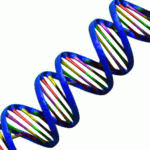Genetics
|
30 august 2014 05:37:32 |
| Development and characterization of low ¿-linolenic acid (BMC Genetics) |
|
Tweet Background:
Traditional canola (Brassica napus L.; AACC, 2n?=?38) cultivars yield seed oil with a relatively high proportion of ?-linolenic acid (ALA; C18:3
cis?9,12,15), which is desirable from a health perspective. Unfortunately, due to the instability of this fatty acid, elevated levels also result in oils that exhibit a short shelf life and problems associated with use at high temperatures. As a result, the development of cultivars bearing reduced amounts of ALA in their seeds is becoming a priority. To date, several low ALA B. napus cultivars (~2-3% ALA of total fatty acids) have been developed and molecular analyses have revealed that the low ALA phenotype of lines tested thus far is a result of mutations within two `class b? FATTY ACID DESATURASE 3 (FAD3) genes. Since B. napus possesses six FAD3 genes (two `class a?, two `class b? and two `class c?) and ALA levels of approximately 2-3% remain in these low ALA lines, it is likely that the mutation of additional FAD3 genes could further decrease the content of this fatty acid.
Results:
In this study, we generated low ALA (?2%) lines of B. oleracea, which is the C genome progenitor species of B. napus, via ethyl methanesulphonate (EMS) mutagenesis. We identified a novel nonsense mutation within the `class a? FAD3 gene (BoFAD3-2) in these lines, which would result in the production of an encoded protein lacking 110 amino acids at its C terminus. When expressed in Saccharomyces cerevisiae, this mutant protein exhibited a drastic decline in its ?-15 desaturase activity compared to the wild-type (wt) protein. Furthermore, we demonstrated that the expression of the mutant BoFAD3-2 gene was significantly reduced in developing seeds of low ALA lines when compared to expression in wt plants.
Conclusions:
Given the additive nature of FAD3 mutations on ALA content and the ease with which B. napus can be re-synthesized from its progenitor species, the mutant isolated here has the potential to be used for the future development of B. napus cultivars exhibiting further reductions in ALA content. |
| 83 viewsCategory: Genetics |
 Ku-Mediated Coupling of DNA Cleavage and Repair during Programmed Genome Rearrangements in the Ciliate Paramecium tetraurelia (PLoS Genetics) Ku-Mediated Coupling of DNA Cleavage and Repair during Programmed Genome Rearrangements in the Ciliate Paramecium tetraurelia (PLoS Genetics)Integration of UPRER and Oxidative Stress Signaling in the Control of Intestinal Stem Cell Proliferation (PLoS Genetics) 
|
| blog comments powered by Disqus |
MyJournals.org
The latest issues of all your favorite science journals on one page
The latest issues of all your favorite science journals on one page



